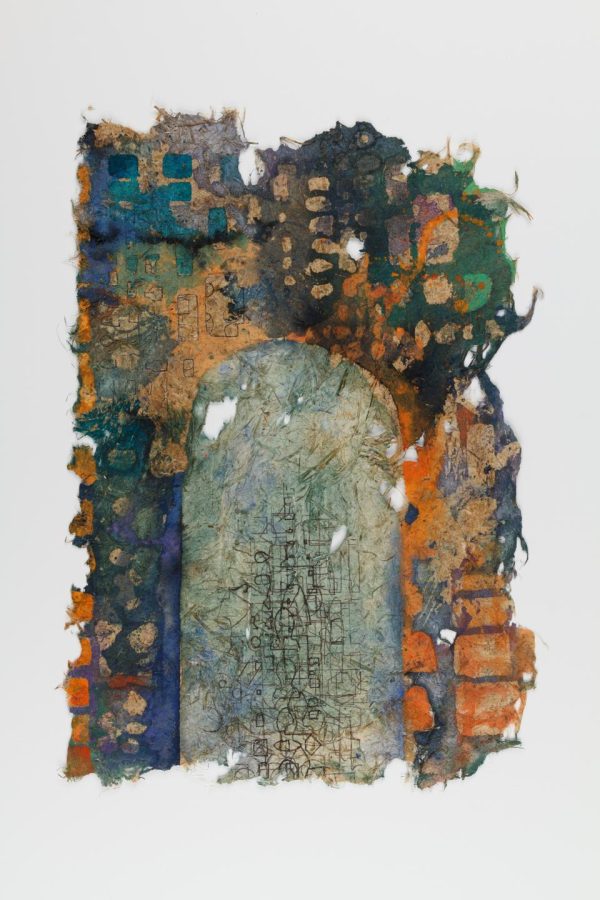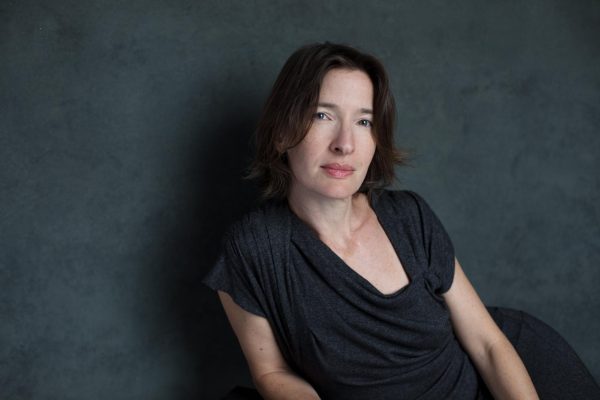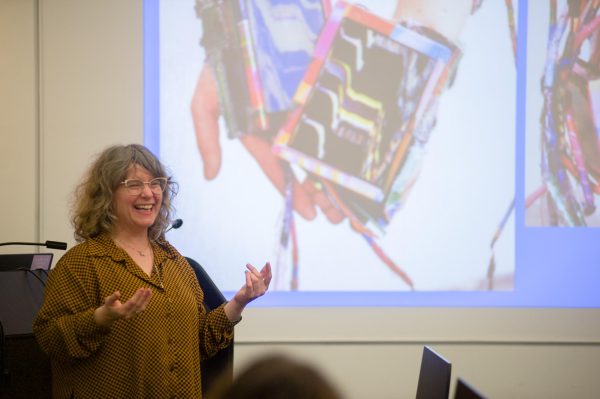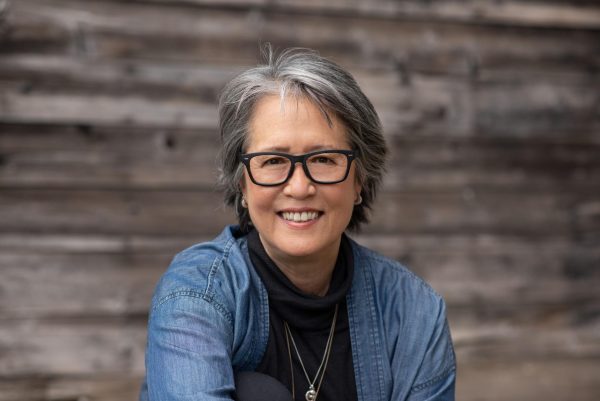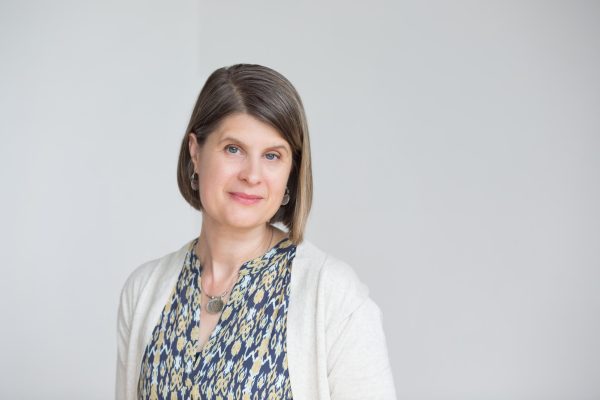Kasia Ozga, Visiting Assistant Professor of Sculpture
The day before Visiting Assistant Professor of Sculpture Kasia Ozga’s installation in the String Room Gallery at Wells College opened, she used a stencil and hay pulp to print the exhibition title on the wall. The installation, RE_MOVE, is the culmination of a year-long transatlantic dialogue between Ozga and the multimedia artist and poet Dan Rosenberg. Ozga has been teaching at Oberlin since fall 2022, guiding students in experimenting with various mediums as she continues to create new work and develop site-specific projects here in Ohio.
This interview has been edited for length and clarity.
Tell me about the current exhibition at Wells College.
I started this project during the pandemic with the poet Dan Rosenberg, who is an associate professor of English at Wells College in upstate New York. At the time, I was actually living in France. I lived in France right up until I moved to Oberlin. I was thinking of a good art form that could deal with the logistical constraints of that time. I had wanted to do some kind of call-and-response dialogue with a creative individual working in another medium for a long time. I have worked with dancers and musicians before, so I thought it would be fun to work with a writer. We had this idea of communicating for a set period of time exclusively through him sending me poems and me responding with images. The duration of the project was determined by the amount of material I had. I had this handmade paper that I used to make sculptures with when I was in grad school. At a certain point I had to take these large sculptures apart, just for storage. I cut them up and repurposed the paper, which is a process of pressing the water out and reforming the sheets. The paper was made from hay in Poland, which is where I went to grad school, and I was just waiting for the right moment to use it. When I had the idea for this correspondence, it seemed like the best use for it.
Did the pandemic influence this dialogue?
It was a time in which everything was so digital, and the palpable dimension of materials was largely removed. I wanted to create something where I would get these poems in a digital format but then give some kind of presence or body to some of the ideas that those poems were invoking. It wasn’t about illustrating the poems. It was really about taking some elements of them and creating a new work that would then be the impetus for Dan’s next contribution in a back-and-forth. Sometimes we had more than one poem or drawing going at one time; it wasn’t totally linear. The work proceeded until there was no more paper.
How does the work itself engage with the gallery space?
At some point we had the idea to display them in a show. We wanted to explore them in space and see how we can both give body to the poems, not by explaining them, as text alongside the images, but really thinking about how texts can affect the space in different ways. In the show, at Wells, sometimes there are fragments of poems that go up columns and on the walls or are printed on windows. There is a poem that’s read by the U.S. Poet Laureate, recorded and projected. Visitors can read the poetry as a part of the space itself. There’s one printed on a scroll and one that’s cut up into trinkets and distributed on the wall. It’s also about getting viewers that walk through the space to see some of these correspondences and to make links between the visual and the textual in new and interesting ways.
What other site-specific elements were you able to include in the installation?
I had the opportunity to be there in residence for a week as we were installing the show, and I did make a site-specific piece for the show. For that piece, I took fresh cut hay from upstate New York and pulped it myself there. I made a wall drawing installation on-site that involved a chimney in the gallery. There is hay coming out of the chimney and a geometric wall drawing with the pulp above it. To transform the consciousness of the material substrate of the work of the pieces was really fun for me.
How did you bring these works out of a digital conversation and into a physical room?
It was the first time Dan physically saw the pieces, which was exciting. We also had to think about how different ways of embodying the texts creates new relationships between the works themselves. I think that the way of installing this exhibition is very specific, because there are these columns in the space, and right away we wanted to use them and even have the work partially go on the floor or in different directions. We even put in a little press in the corner of the exhibition where people could do a letterpress version that they can take home with them. When we show the work elsewhere, reinstalling it in relation to that site will be part of the process for us now. We are always thinking, how does the architecture, the site where the work is really represented, play a part in the experience of all the pieces?
What are you working on currently?
I’m working on lots of different stuff right now, everything from soft sculptures and textile-based works involving blue workwear that I was working with in France. I’m also working on another project involving Native American Hopewell culture really concentrated in Ohio. When I moved here, I was really interested in creating something site-specific to this place and also thinking about how we situate ourselves in relation to time because of my life experience of moving into different sites. While reading and thinking about topics that interest me here specifically, Hopewell culture and earthworks were something that I discovered. The more I read about them, the more interested I became in this capacity of Indigenous people creating earthworks the size of football fields with an insane amount of geometric precision back in 400 AD. These are, of course, extremely impressive, but also speak to this overarching question of, “How do we position ourselves in relation to the time that we live in and larger ideas about cycles, beyond the scale of human life?” I’ve started to make some artworks based on these forms that also incorporate CNC chatbot technology. When using these wood-carving technologies a fair amount of glitching happens, which is also interesting in terms of thinking about areas of control as we make artworks. It has also been fun because I’ve been able to talk to different researchers in a really interesting interdisciplinary way.
Are you planning to continue working in collaboration with text after this project?
Even the show title — on the wall tag when you walk in — was an interesting collaboration between my materials and Dan’s text. We had wall tags that were printed in vinyl, but we forgot to do the title. The day before the show opened, I made a stencil of the text and then used the pulp to print it on the wall. That was really fun. I want to do some more wall text posting. I brought a lot of the pulp back here, so I kind of want to put it everywhere.


